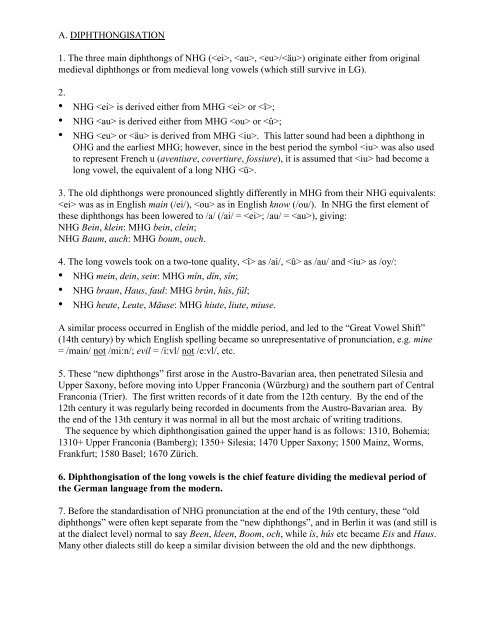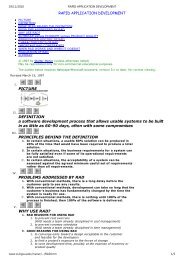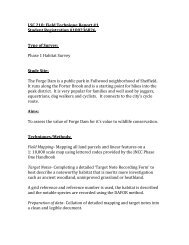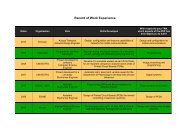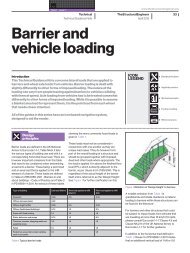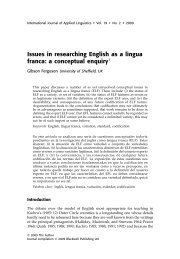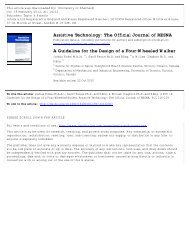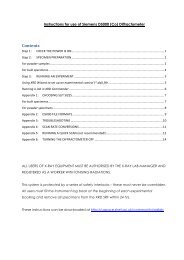A. DIPHTHONGISATION 1. The three main diphthongs of ... - uSpace
A. DIPHTHONGISATION 1. The three main diphthongs of ... - uSpace
A. DIPHTHONGISATION 1. The three main diphthongs of ... - uSpace
You also want an ePaper? Increase the reach of your titles
YUMPU automatically turns print PDFs into web optimized ePapers that Google loves.
A. <strong>DIPHTHONGISATION</strong><br />
<strong>1.</strong> <strong>The</strong> <strong>three</strong> <strong>main</strong> <strong>diphthongs</strong> <strong>of</strong> NHG (, , /) originate either from original<br />
medieval <strong>diphthongs</strong> or from medieval long vowels (which still survive in LG).<br />
2.<br />
• NHG is derived either from MHG or ;<br />
• NHG is derived either from MHG or ;<br />
• NHG or is derived from MHG . This latter sound had been a diphthong in<br />
OHG and the earliest MHG; however, since in the best period the symbol was also used<br />
to represent French u (aventiure, covertiure, fossiure), it is assumed that had become a<br />
long vowel, the equivalent <strong>of</strong> a long NHG .<br />
3. <strong>The</strong> old <strong>diphthongs</strong> were pronounced slightly differently in MHG from their NHG equivalents:<br />
was as in English <strong>main</strong> (/ei/), as in English know (/ou/). In NHG the first element <strong>of</strong><br />
these <strong>diphthongs</strong> has been lowered to /a/ (/ai/ = ; /au/ = ), giving:<br />
NHG Bein, klein: MHG bein, clein;<br />
NHG Baum, auch: MHG boum, ouch.<br />
4. <strong>The</strong> long vowels took on a two-tone quality, as /ai/, as /au/ and as /oy/:<br />
• NHG mein, dein, sein: MHG mîn, dîn, sîn;<br />
• NHG braun, Haus, faul: MHG brûn, hûs, fûl;<br />
• NHG heute, Leute, Mäuse: MHG hiute, liute, miuse.<br />
A similar process occurred in English <strong>of</strong> the middle period, and led to the “Great Vowel Shift”<br />
(14th century) by which English spelling became so unrepresentative <strong>of</strong> pronunciation, e.g. mine<br />
= /<strong>main</strong>/ not /mi:n/; evil = /i:vl/ not /e:vl/, etc.<br />
5. <strong>The</strong>se “new <strong>diphthongs</strong>” first arose in the Austro-Bavarian area, then penetrated Silesia and<br />
Upper Saxony, before moving into Upper Franconia (Würzburg) and the southern part <strong>of</strong> Central<br />
Franconia (Trier). <strong>The</strong> first written records <strong>of</strong> it date from the 12th century. By the end <strong>of</strong> the<br />
12th century it was regularly being recorded in documents from the Austro-Bavarian area. By<br />
the end <strong>of</strong> the 13th century it was normal in all but the most archaic <strong>of</strong> writing traditions.<br />
<strong>The</strong> sequence by which diphthongisation gained the upper hand is as follows: 1310, Bohemia;<br />
1310+ Upper Franconia (Bamberg); 1350+ Silesia; 1470 Upper Saxony; 1500 Mainz, Worms,<br />
Frankfurt; 1580 Basel; 1670 Zürich.<br />
6. Diphthongisation <strong>of</strong> the long vowels is the chief feature dividing the medieval period <strong>of</strong><br />
the German language from the modern.<br />
7. Before the standardisation <strong>of</strong> NHG pronunciation at the end <strong>of</strong> the 19th century, these “old<br />
<strong>diphthongs</strong>” were <strong>of</strong>ten kept separate from the “new <strong>diphthongs</strong>”, and in Berlin it was (and still is<br />
at the dialect level) normal to say Been, kleen, Boom, och, while îs, hûs etc became Eis and Haus.<br />
Many other dialects still do keep a similar division between the old and the new <strong>diphthongs</strong>.
B. MONOPHTHONGISATION<br />
<strong>1.</strong> Once a gap had been created in the phonology <strong>of</strong> German by the loss <strong>of</strong> the long vowels,<br />
certain other ancient medieval <strong>diphthongs</strong> began to lose their diphthongality and simplify as new<br />
long vowels (“monophthongs”), settling in the places left by old , and .<br />
2. <strong>The</strong> old <strong>diphthongs</strong> in question were medieval , , . <strong>The</strong> sounds these<br />
represented in medieval phonology were as follows:<br />
: as in English ear; IPA []<br />
: as in English who <strong>of</strong>; IPA []<br />
: NHG + ; IPA [].<br />
<strong>The</strong>se pronunciations can still be heard with only slight variation in modern Swiss and Austrian<br />
German.<br />
3. As a result <strong>of</strong> monophthongisation,<br />
• medieval became pronounced /i:/, although the spelling in NHG re<strong>main</strong>s the same as the<br />
medieval (the added in NHG is taken as lengthening the , not turning it into a<br />
diphthong):<br />
• NHG fliegen, Lied, wie: MHG fliegen, liet, wie;<br />
• medieval became /u:/, written medially (in the middle <strong>of</strong> a word) as or finally (at<br />
the end <strong>of</strong> a word) as :<br />
• NHG Bruder, Huhn, Kuh: MHG bruoder, huon, kuo;<br />
• medieval became /y:/, written medially as , finally as :<br />
NHG Füße, kühl, kühn: MHG füeze, küele, küene.<br />
4. Following on from new diphthongisation, monophthongisation first arose in the central part <strong>of</strong><br />
Germany, taking in northern Alsace and Rhineland Franconia, from where it spread to East<br />
Franconia, Thuringia, Upper Saxony, Silesia and the northern part <strong>of</strong> Central Franconia<br />
(Cologne).<br />
Give modern equivalents <strong>of</strong> the following MHG words and define the process <strong>of</strong> change<br />
involved; also give the modern Dutch equivalent:<br />
<strong>1.</strong> biutel<br />
2. bîzen<br />
3. blüete<br />
4. bluome<br />
5. bluot<br />
6. brief<br />
7. bû<br />
8. fleisch<br />
9. frî<br />
10. grîfen<br />
1<strong>1.</strong> grüene<br />
12. guot<br />
13. heiz<br />
14. hiulen<br />
15. hiute<br />
16. hût<br />
17. kleit<br />
18. koufen<br />
19. loufen<br />
20. meinen<br />
2<strong>1.</strong> meist<br />
22. müede<br />
23. mûs<br />
24. niun<br />
25. ouge<br />
26. pfîfe<br />
27. rîch<br />
28. Rîn<br />
29. rouchen<br />
30. schiezen<br />
3<strong>1.</strong> schînen<br />
32. stein<br />
33. sû<br />
34. süeze<br />
35. sûfen<br />
36. suochen<br />
37. tief<br />
38. tiufel<br />
39. trîben<br />
40. troum<br />
4<strong>1.</strong> trüebe<br />
42. weinen<br />
43. wîn<br />
44. zît


